Chiller Heater Thermostats for Mixing Reaction
Kontaktieren Sie uns noch heute für die perfekte Lösung zur Temperaturkontrolle
The temperature control of the mixing reactor is a crucial link, and the heater chiller is the equipment used to realize the cooling and heating of the reactor.
A heater chiller, also called a laboratory thermostat, is a device that adjusts and controls temperature by circulating water. It uses refrigerant to absorb heat energy in the air and discharges it through water cooling. During this process, the state of the refrigerant will change, and then it will be compressed and recycled.
Specifically, the integrated cooling and heating machine absorbs the heat around the reaction kettle through cooling water circulation. After the cooling water is heated, it enters the interior of the refrigeration machine through the pipeline. The interior of the refrigeration machine discharges the heat to the air, and at the same time, the cooling water is cooled again before being transported. Return to the reactor for circulation. In this way, the temperature in the reactor can be accurately controlled within the set value range, allowing chemical substances to react under ideal temperature conditions, thereby obtaining better chemical reaction effects.
Since the temperature control method of the heater chiller adopts circulating water cooling and heating, it has the characteristics of rapid response, no pollution to the environment, and stable temperature. Cooling heating systems have been widely used in high-temperature control fields such as pharmaceuticals, chemicals, food, and semiconductors, and have become an important part of modern heating and cooling technology.
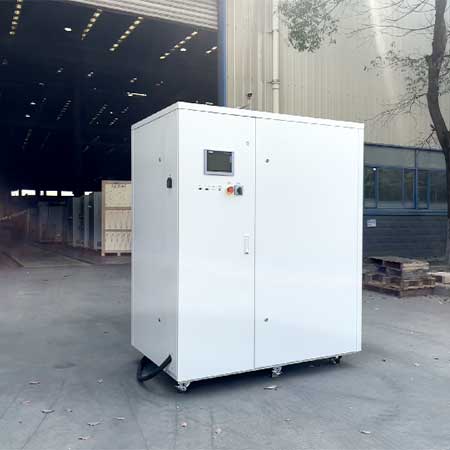
The working principle of heater and chiller is as follows:
1. Refrigeration process: In the refrigeration cycle system, the refrigerant is compressed into high-temperature and high-pressure gas, and then cooled and decompressed through the expansion valve, and converted into low-temperature and low-pressure gas. At this time, the refrigerant can absorb the heat of surrounding objects.
The absorbed heat is transported to the condenser through the refrigerant pipe, and then the heat is transferred to the outside air. At this time, the refrigerant becomes a high-temperature and high-pressure gas, and the cycle begins.
2. Heating process: In the heating cycle system, the water source or thermal oil is heated by the electric heater, and the heat transfer device introduces the heat of the heating medium into the refrigeration cycle system, thereby raising the temperature of the refrigerant, and transporting the refrigerant through circulation. Heat is transferred to the object to be heated.
The integrated cooling and heating machine combines the heating and refrigeration cycle systems into one, and realizes cooling and heating by switching valves and electronic control systems, thereby achieving constant temperature control of objects. It is widely used in industrial production fields, such as thermoforming processing, electronic component manufacturing, chemical industry, pharmaceuticals, metallurgy and other fields to improve product quality and production efficiency.
Wir bieten die Entwicklung und Herstellung kompletter Temperaturkontrollsysteme an. Von Standardmodellen bis zu kompletten kundenspezifischen Produkten bis hin zu 900 Tonnen. Wir haben uns auf den Kundenservice spezialisiert und sind bestrebt, jedem Kunden zu helfen, das optimale Temperaturkontrollsystem für seinen spezifischen Bedarf zu finden.
Wir bieten maßgeschneiderte Lösungen, die nicht dem Standard entsprechen. Es sind sowohl einzelne Kühlaggregate als auch kombinierte Kühl- und Heizaggregate erhältlich.
E-Mail: lilia@lneya.com WeChat ID: +8615251628237 WhatsApp: +86 17851209193


Kühl- und Heizsysteme (Serie SUNDI)
- Temperaturbereich: -120℃ ~ +350℃
- Hochpräzise, intelligente Temperaturregelung
- Kühlleistung: 0,5kW ~ 1200kW
- Vollständig geschlossenes System zur Verlängerung der Lebensdauer des Thermofluids
- Jedes Gerät wird mehr als 12 Stunden lang einem Belastungstest unterzogen.
| Temperaturbereich | Serie -10 ~ +150°C | Serie -25 ~ +200°C | Serie -25 ~ +300°C | Serie -45 ~ +250°C | Serie -45 ~ +300°C | Serie -60 ~ +250°C | Serie -60 ~ +300°C | Serie -70 ~ +250°C | Serie -80 ~ +250°C | Serie -90 ~ +250°C | Serie -100 ~ +100°C | ||
| Kühlleistung | 1,5 ~ 15kW | 1 ~ 200kW | 1 ~ 200kW | 0,45 ~ 200kW | 0,9 ~ 25kW | 0,25 ~ 60kW | 0,75 ~ 25kW | 0,4 ~ 15kW | 0,3 ~ 80kW | 0,2 ~ 80kW | 0,45 ~ 80kW | ||
| Hinweis: Jeder Temperaturbereich von -150℃ ~ +350℃ und jede Kühlleistung kann angepasst werden | |||||||||||||
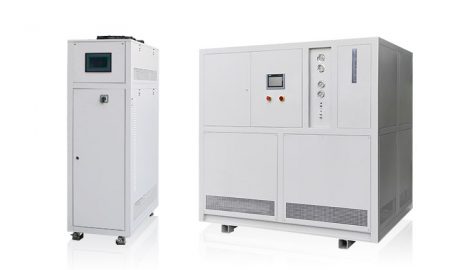
Kühl- und Heizsysteme (WTD-Serie)
- (Mikrokanal / Röhrenreaktoren spezialisiert)
- Temperaturbereich: -70℃ ~ +300℃
- Leistungsstarke Umwälzpumpe, stabilere Temperaturregelung
- Breiter Temperaturbereich zur Erfüllung der Anforderungen mehrerer Branchen
- Jedes Gerät wird mehr als 12 Stunden lang einem Belastungstest unterzogen.
| Temperaturbereich | -70°C ~ +300°C | -45°C ~ +250°C | -70°C ~ +200°C | ||||||
| Kühlleistung | 1.1 ~ 7.5kW | 1.5 ~ 5.5kW | 11 ~ 50kW | ||||||
| Hinweis: Jeder Temperaturbereich von -150℃ ~ +350℃ und jede Kühlleistung kann angepasst werden | |||||||||

Umwälzpumpen für Kühlung und Heizung
- Temperaturbereich: -45℃ ~ +250℃
- Emerson Copeland Kompressor, zuverlässige Qualität
- Selbstdiagnosefunktion, mehrere Sicherheitsschutzvorrichtungen
- Vollständig geschlossenes System zur Verlängerung der Lebensdauer des Thermofluids
- Jedes Gerät wird mehr als 12 Stunden lang einem Belastungstest unterzogen.
| Temperaturbereich | Serie -25°C ~ +200°C | Serie -45°C ~ +250°C | |||||||
| Kühlleistung | 1 ~ 15kW | 0,25 ~ 15kW | |||||||
| Hinweis: Jeder Temperaturbereich von -150℃ ~ +350℃ und jede Kühlleistung kann angepasst werden | |||||||||
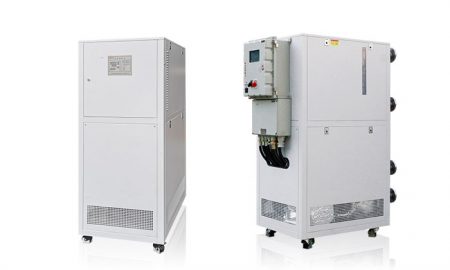
Heizungsumwälzpumpen
- Temperaturbereich: +50℃ ~ +300℃
- Große Wärmeaustauschfläche und schnelle Aufheizgeschwindigkeit
- Selbstdiagnosefunktion, mehrere Sicherheitsschutzvorrichtungen
- Geschlossenes Kreislaufsystem, kein Ölnebel bei hohen Temperaturen
- Jedes Gerät wird mehr als 12 Stunden lang einem Belastungstest unterzogen.
| Temperaturbereich | +50°C ~ +170°C (UC-Serie) | +50°C ~ +300°C (UC-Serie) | +50°C ~ +300°C (UST-Serie) | ||||||
| Heizleistung | 5,5 ~ 15kW | 3,5 ~ 130kW | 3,5 ~ 95kW | ||||||
| Hinweis: Jeder Temperaturbereich von -150℃ ~ +350℃ und jede Kühlleistung kann angepasst werden | |||||||||
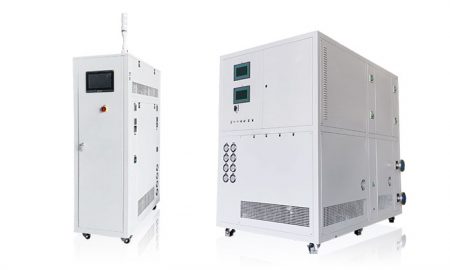
TES-Serie (Temperaturregelung für Kraftstoff- und Öltests)
- Temperaturbereich: -85℃ ~ +250℃
- Siemens PLC-Steuerung und anderes Markenzubehör
- Selbstdiagnosefunktion, mehrere Sicherheitsschutzvorrichtungen
- Vollständig geschlossenes Kreislaufsystem, kein Ölnebel bei hohen Temperaturen
- Jedes Gerät wird mehr als 12 Stunden lang einem Belastungstest unterzogen.
| Temperaturbereich | Serie -45°C ~ +250°C | Serie -85°C ~ +200°C | Serie -60°C ~ +200°C | ||||||
| Kühlleistung | 0,3 ~ 25kW | 0,25 ~ 25kW | 3 ~ 60kW | ||||||
| Hinweis: Jeder Temperaturbereich von -150℃ ~ +350℃ und jede Kühlleistung kann angepasst werden | |||||||||
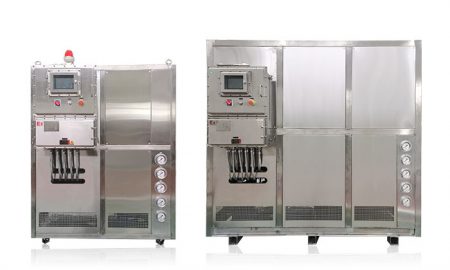
TCU Multireaktoren Temperaturkontrollsystem
- Temperaturbereich: -120℃ ~ +250℃
- Versiegelte, wiederholbare Temperaturkontrolle
- Eingebautes Thermoöl-Hilfssystem für elektrische Heizung
- Hinzufügen von Kälte- und Wärmequellen-Wärmetauschermodulen je nach Bedarf
- Jedes Gerät wird mehr als 12 Stunden lang einem Belastungstest unterzogen.
| Temperaturbereich | Serie -45°C ~ +250°C | -120°C ~ +250°C Reihe | Kundenspezifisches Temperaturkontrollsystem | RT+10°C ~ +135°C | |||||
| Heizleistung | 25 ~ 80kW | 25 ~ 80kW | Benutzerdefiniert | 25 ~ 300kW | |||||
| Hinweis: Jeder Temperaturbereich von -150℃ ~ +350℃ und jede Kühlleistung kann angepasst werden | |||||||||
 LNEYA
LNEYA
 简体中文
简体中文


















































































